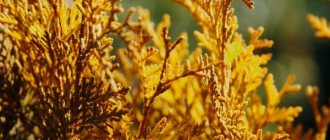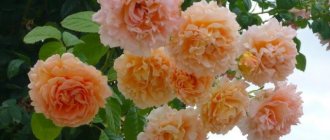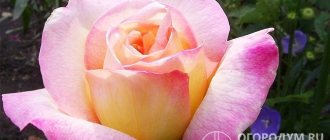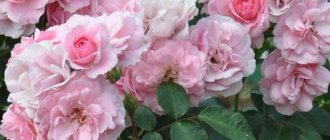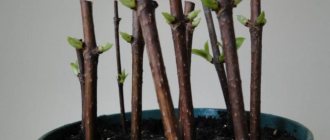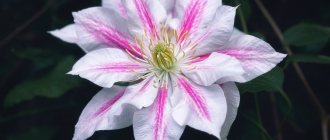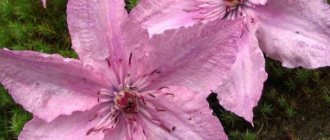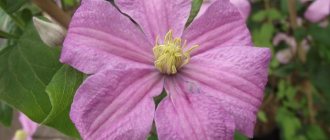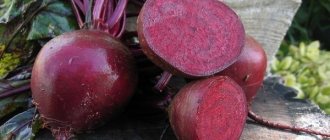Thuja occidentalis Woodwardie is an evergreen spherical conifer that belongs to the Cypress family. The plant can successfully fit into any landscape design, and therefore has gained wide popularity among beginners and experienced gardeners. At the same time, the crop easily tolerates the polluted air of cities and emits medicinal phytoncides that inhibit the vital activity of bacteria and viruses. Therefore, it is recommended to use Woodwardi thuja for landscaping public parks and squares, as well as personal plots.
Western Thuja Woodwardie can grow in one place for more than 100 years
Description and characteristics
When choosing this conifer, you need to familiarize yourself with the characteristics of its growth and development. The information will help you correctly plant Woodwardi thuja on your site and combine it with other garden crops.
Mature plant height
Western Thuja Woodwardi is one of the medium-sized conifers. The height of the plant at the age of 10 years does not exceed 1.0-1.5 m. An adult conifer grows up to 2.0-2.5 m. It can reach such a height by the age of thirty if favorable conditions exist.
Width
Thuja Woodwardi develops equally in both height and width. Therefore, by the age of 10, this figure is 1.2-1.5 m. But over time, the Woodwardi thuja becomes wider and reaches 3.0 m. Therefore, when planting, you need to pay attention to this feature.
Important! If there is insufficient free space, the decorativeness of the Woodwardi thuja decreases, so it must be placed taking into account the maximum width.
Crown diameter
Thuja Woodwardi has a compact, dense crown. Initially it has a regular spherical shape, but over time it becomes dome-shaped. The shoots are straight, flattened. They are densely covered with dark green scaly shiny needles. In spring it has a golden hue, and in winter it acquires a brown tint.
The diameter of the crown of an adult thuja Woodwardi in the lower part reaches 2.5-3.0 m. And towards the top with age it narrows slightly and amounts to 2.0 m.
Important! When planting conifers in deep shade, the crown becomes loose and loses its shine.
Growth rate
Western Thuja Woodwardie is characterized by slow growth. Over the course of a year, it gains about 5 cm in height and width. Therefore, when growing this type of conifer, you need to be patient.
Root system
The underground part of the thuja Woodwardi is branched and superficial. It consists of main roots and small lateral shoots, which develop in combination with mycorrhiza. Therefore, when planting, it is not recommended to violate the integrity of the earthen coma, otherwise the plant may die.
The branching radius of the root system of Thuja Woodwardi is 2.0 m
Thuja Woodwardi: photo of what the variety looks like
Thuja Woodwardi in landscape design: photo
- The crown has a round shape, from a distance it looks like a ball. Many shoots form the shape of the plant. The crown of the thuja has a green-beige color. The interesting thing is that the upper stems are much shorter than those in the middle or bottom of the plant, the stems grow straight and branch towards the top.
- This variety has a very dense crown, with small scales on it. The crown is closely adjacent to the shoot, usually its average length is about 5 centimeters. The needles are colored evenly, without bald spots, and every year it remains the same, without changing. The foliage of the thuja is very tough, but it does not prick, so it is impossible for it to get hurt. Every year the plant sheds its old crown, which is replaced by a young crown.
- Cones are present, but their number is very small. They have a brown-beige color. Just like needles, they have scales, increase in size every year and produce yellow seeds that have thin and transparent wings.
- Woodwardie belongs to the dwarf varieties, since their height is quite small compared to other varieties, but the advantage of dwarf thujas is that they are wind-resistant and do not respond to changes in environmental factors and temperatures. Arborvitae can also be planted on the floor in shaded areas and in sunny places.
- The root system is mixed and has long roots. The roots growing on the sides are tightly intertwined and thereby deliver as many useful microelements from the soil as possible.
Note : Seeds of this variety can be planted, as they retain all the hereditary information about the variety.
Planting and care
To achieve maximum decorative value when growing Western Thuja Woodwardi, it is necessary to plant the plant in open sunny areas, protected from strong gusts of wind. In this case, light shading during the midday hours is acceptable. This will prevent the needles from burning out in early spring and during hot summer periods.
Important! When placing the Woodwardi thuja in deep shade, it initially begins to wither and then dies.
Two-year-old thuja Woodwardi seedlings adapt most quickly to a new place and grow, since they already have a well-developed root system. Therefore, you need to choose them for planting. Thuja Woodwardi, like other types of conifers, does not tolerate even slight drying out of the root system, which leads to disruption of mycorrhiza. Therefore, when purchasing, you should give preference to seedlings with a closed root system.
Thuja Woodwardi is undemanding to soil composition. But at the same time, the soil must have a low level of acidity and good moisture and breathability. The most suitable option for this conifer may be loam and sandy loam soil.
Important! If you need to plant a plant in heavy clay soil, you should first add peat and sand.
It is recommended to begin preparing the site for thuja Woodwardi 2 weeks before planting. It must be dug up to the depth of a shovel and the surface carefully leveled. Then prepare a planting hole 60 cm wide and 80 cm deep. Place a 15 cm thick layer of broken brick on the bottom. The remaining 2/3 of the volume should be filled with a nutrient mixture consisting of equal parts:
- peat:
- sand;
- leaf soil;
- turf.
You also need to additionally add nitroammophoska at the rate of 100 g per plant and mix it thoroughly with the soil.
Important! You should not add nitrogen fertilizers when planting, as they interfere with rooting.
A day before planting, the thuja seedling in the container should be watered to reduce the likelihood of damage to the roots.
Algorithm of actions when planting thuja Woodwardi:
- Water the planting hole and wait until the water is absorbed.
- Carefully remove the plant from the container without damaging the earthen ball.
- Place the seedling in the center so that the root collar is at soil level.
Thuja Woodwardi is one of the largest spherical varieties of culture
- Fill all the resulting voids with earth.
- Compact the soil at the base of the seedling.
- Water again.
The next day, it is necessary to lay a 3 cm layer of mulch in the root circle. To do this, you can use rotted bark, sawdust or peat. This will maintain the soil's breathability and prevent the roots from drying out.
At what distance to plant
When planting Woodwardi thuja, it is necessary to maintain a distance of at least 1.5 m from other tall crops. This distance is quite enough so that the plants do not compete with each other for food and water.
If this conifer is used to create a “living” hedge, the distance between the seedlings should be about 1.0 m. This will allow them to close together over time, but at the same time there will be enough space for the full development of each.
Watering and fertilizing
Only young thuja Woodwardi seedlings need regular watering. For irrigation it is necessary to use settled water. The procedure should be carried out 1-2 times a week, depending on the air temperature. In this case, the soil should be wetted by 20 cm, so at least 15-20 liters of water must be poured under each seedling.
Adult Woodwardi thujas do not need regular watering. Sometimes you can only wash their crown from dust using sprinkling.
You should start feeding the conifers 3 years after planting. Until this time, the seedling will consume the nutrients that were placed in the hole. Fertilizers should be applied twice per season. The first time in the spring at the beginning of the growing season, using mineral mixtures with a high nitrogen content, which activates growth processes. The second is in mid-summer. During this period, phosphorus-potassium fertilizers should be used. This feeding accelerates the maturation of young shoots and increases the frost resistance of thuja.
How to trim
In early spring, it is necessary to carry out sanitary cleaning of the crown. During this period, all frozen and damaged shoots should be removed. In addition, throughout the season it is necessary to shape the crown, cutting off the tops of branches that stand out from their total mass.
Important! Thuja Woodwardi responds well to pruning and recovers quickly after it.
General information about planting Western Thuja Woodwardie
The planting process must be done very carefully so that the roots of the plant are not affected. Before carrying out the process, it is necessary to treat the root system using a manganese solution, place the roots in the solution for 4 hours and then with Kornevin, the root system should stay in this solution for 2-2.5 hours. If the generative method was used when growing the seedling, then planting is carried out together with soil from the pot. If dry roots are present, they must be removed and treated with the same means. If the seedling was purchased in a specialized store or nursery, then no measures need to be taken before planting. Since in nurseries such treatment is regularly carried out.
When to plant thuja
An adult thuja bush is considered one of the most frost-resistant plants. It can withstand temperatures as low as -38 degrees, and such frost will not in any way affect the functioning, development and growth of the plant. Of course, thujas that have been recently planted are not so resistant, but they can still withstand low temperatures. Experts do not recommend autumn planting, as the risk that the thuja will die increases. It can only be done at warm temperatures; usually such planting is done in the southern regions. In other areas, such planting is carried out only in warm autumn and well-warmed soil, about +10-15 degrees. Therefore, thuja is planted either in autumn or spring, depending on the planting area and the temperature of the season.
Where to plant thuja
Wurwardi loves light and warmth, so the place should be well lit and not have strong winds or drafts. The place can be semi-shaded, this will not affect the plant in any way. Wurwardi is not only frost-resistant, but also highly resistant to drought, but does not tolerate excess moisture in the air or soil. Therefore, hydration should be moderate. There should be no reservoirs, swamps, or groundwater near the planting site. All this will have an impact on thuja, and not a very good one at that. The best place for landing is considered to be a small hill, since there is usually no water nearby.
Soil preparation
The soil should be light and fertile, and also well loosened so that air can easily penetrate the soil. The acidity of the soil should never be increased. Otherwise, the crown will grow unevenly and the brightness of the needles will decrease. Before planting, you need to dig up the area well, thereby loosening it. If the acidity is high, alkaline agents must be added to the soil to reduce the acidity. You should also feed the soil with a mixture that includes sand, torus, turf layer, compost and phosphate.
Landing instructions
Before planting, 48 hours before, you need to prepare a hole in which the plant will be planted. It should be of medium depth, about 60 centimeters, and an average diameter, about 55 centimeters. This hole must be well watered so that moisture gets into the deep layers of the soil.
1.First, you need to install drainage. To do this, you need to pour expanded clay, broken brick or pebbles at the bottom of the soil. The layer should be about 25 centimeters. 2.Then the drainage is filled with soil and fertilizer and a small mound is formed. 3.The thuja root system is installed in this mound. 4.The roots are covered with soil and fertilizer so that the neck of the roots protrudes 3 centimeters from the ground. 5. The soil is well compacted and watered with warm water. 6.After the water has been absorbed, mulching must be done to keep it in the soil. For mulch, you can use peat, wood chips or hay.
Note: If you want to create a living fence of thujas, then you need to leave about 70 centimeters between crops.
Reproduction
This type of conifer can be propagated by cuttings. They need to be cut from the top of the crown, 10-15 cm long with a “heel”. It is necessary to plant cuttings in wide containers filled with sand and peat in equal volumes. They should be buried 1.0-1.5 cm into the moistened soil, having previously powdered the lower cut with any root former. It is recommended to transplant young seedlings to a permanent place only next spring, if they are strong enough.
Important! Rooting of thuja Woodwardi cuttings occurs after 1.5-2 months.
Features of reproduction
According to the description of the variety, thuja western Woodwardy reproduces by seeds and vegetatively. The generative method is the most productive, but it will take longer; 3 years should pass from the moment the seeds are planted and the thuja seedling is placed on the site. The vegetative method will give results faster, but not all harvested material will be able to take root.
Recommendations for propagating Western Thuja Woodwardie:
- Seeds. Planting material ripens in mid-autumn - this is the time to collect cones. Seeds are sown immediately in containers or a greenhouse. The containers are left on the site for the winter. Until spring, the seeds will undergo natural stratification, at the end of May young shoots will appear, the covering structure is removed, and the plant is watered. For the winter, seedlings are protected from frost. The next year, in mid-July, strong seedlings are selected and planted in separate small containers and covered for the winter. The following year, thuja seedlings are planted.
- By cuttings. To propagate thuja western Woodwardi, material is harvested from two-year-old shoots. They take strong branches, the middle will go into cuttings 25-30 cm long. The cuts are treated with a 5% manganese solution and planted in fertile soil. During the summer they are constantly watered and covered for the winter. Next year, the rooted material will form the first shoots; successfully overwintered thuja seedlings are planted on the site in the spring.
- By layering. The work is carried out at the end of May, a furrow 6 cm deep is dug near the bush, the lower stem is placed in it, fixed, and covered with soil. The next year in the spring (after the emergence of seedlings), plots are cut and planted.
Reproduction of thuja Woodwardi by layering is the fastest way, but less productive, because the survival rate of seedlings is low.
Advice! By autumn it will be possible to determine which plots have taken root; they must be insulated for the winter.
Application in landscape design
This conifer is very popular among gardeners due to its dense spherical crown. Thuja Woodwardi can be a solitaire in landscape design, and can also be part of group compositions.
Successful companions for her can be:
- spirea;
- jasmine;
- juniper;
- spring bulbous plants;
- roses;
- hosts;
- peonies;
- heuchera;
- bergenia.
Landscape designers recommend using Woodwardi thuja to create alleys, divide a site into zones, as a “hedge”, and also for coniferous “balls”.
Important! This conifer can also be grown as a tub crop, using it to decorate terraces, balconies, and stairs.
Thuja Woodwardi is one of the largest spherical varieties of culture
Description of the plant
Thuja Woodwardi enjoys extraordinary success as an ornamental shrub.
Small size, deep green color and spectacular aroma are the main advantages of the plant. It is also worth noting its unpretentiousness. Unique qualities helped this variety easily conquer European and then Russian markets.
A characteristic feature is the spherical or ovoid shape of the crown. The shrub has dense needles. The color can range from light to dark rich green.
The tree grows slowly, reaching 0.5 m within 10 years. The maximum height is 2.5 m. As life progresses, the shape of the ball becomes more oval.
Advantages of thuja:
- reacts well to polluted air;
- tolerates cold;
- unpretentious in care.
Pests and diseases
Thuja Woodwardi has high natural immunity. Therefore, if growing conditions are observed, it does not suffer from diseases. But in order to minimize the likelihood of damage, it is necessary to carry out preventive treatment of the crown twice a season with the drug “Skor”.
Thuja should be treated with fungicide at least 2 hours before rain
Among the pests that can cause damage to conifers are thuja aphids and false scale insects. To combat them, it is recommended to use Actellik. The crown should be sprayed at the first signs of damage and again after a week.
Actellik should be used in dry, windless weather.
Protection
Due to poor tolerance of excess moisture, the plant may develop late blight. This fungus infects the plant and it begins to rot. To avoid this problem, you need to install drainage and monitor watering of the plant. If infected, remove the infected parts and treat with antifungal drugs or a solution of Bordeaux mixture. Gardeners usually treat thuja with Kartotsid.
Among the pests, thuja can be infected with aphids, which can be gotten rid of using a soap solution, moths, Fumitox will help get rid of moths, and spider mites, colloidal sulfur will help get rid of them. In order for the thuja to be healthy and for various pests not to settle on it, it is necessary to carry out preventive treatment with various antifungal drugs.
Preparing for winter
Thuja Woodwardi can withstand temperatures down to -40 degrees. But young seedlings do not have such resistance. Therefore, they need to be covered for the winter. To do this, it is necessary to lay mulch at the base of the plant 7 cm thick. And also make a wooden frame the height of a conifer and wrap it with agrofibre.
When snow falls, conifer branches may bend under the weight. To avoid deformation of the crown, it is recommended to tie the shoots of thuja Woodwardi with a rope, regardless of the age of the plant.
Thuja Woodwardi: description of care
Watering
Thuja requires basic care as it does not require more. Basic care will keep it looking healthy and protect it from pests and diseases. The variety needs to be watered about twice every 7 days, such watering is carried out only during the first 4 four years, then it decreases and is reduced to twice a month. Watering depends on the weather; in case of drought, it is necessary to water much more often than 2 times every 30 days. Before watering, all debris and weeds must be removed, and after watering, the soil must be loosened.
Fertilizer
In order for the thuja to grow evenly, it must be fed. Fertilizer is applied only 36-40 months after transplanting into open ground. All those nutrients that were added to the soil will be consumed during this time, then they will run out and it will be necessary to fertilize. If you fertilize in the spring, then you need to add potassium or phosphorus fertilizer, and if you fertilize in the summer, then you need to add organic fertilizer.
Trimming
It is not necessary to trim thuja, as it grows slowly. The only thing that needs to be done is sanitary pruning. It consists of pruning dry and diseased shoots and parts of needles. Formation is carried out at the request of the gardener. If you like the natural shape of the bush, then no shaping is required. But, if you are a dreamer and want to do something original with the thuja, then you can give it a shape. All pruning and shaping work should be carried out only in warm weather, when there is no scorching sun or rain.
Preparing for winter
Since thuja tolerates various temperature changes well, it does not need to be specially prepared for the winter period; it will survive the winter just fine without shelter. Only at a young age, mulching with a thick layer may be necessary, since young thujas cannot tolerate such severe frosts as adults. Mulching can be done with earth, hay or other material. Before wintering, you should hill up the plant, make a thicker layer of mulch, cover the crown with material that will repel moisture and cover the bush with snow.
Description
Western Thuja "Woodwardy" is a coniferous perennial. The size of the tree is not very impressive - in 10 years of life it barely crosses the 50 centimeter mark. However, an adult plant can grow to a height of 2 or 3 meters - the crown diameter in this case will be approximately 3 meters. The main advantages of this variety are its visual appeal, as well as resistance to negative environments.
For example, “Woodwardy” can grow well even in polluted city alleys.
The shoots are covered with needles of a beautiful green hue, which persists throughout the winter months. On adult thujas, cone-shaped fruits of a rich brown color appear, then they are combined into small panicles.
Landing
Vurvardi, like all conifers, is a light-loving crop. The optimal place for planting is sunny areas or partial shade. In good lighting, the color of the crown becomes brighter.
Like all Western species of thuja, it is undemanding to soils. However, well-moistened, nutritious and drained soil gives a more decorative result.
Has a negative attitude towards moisture stagnation. Excess water can lead to rotting of the roots and the formation of fungus.
Selection of seedlings
Young seedlings should be purchased only with a closed root system. As a last resort, with a lump of earth wrapped in thick, dark-colored fabric.
If the roots of the plant are visible through the drainage holes, this indicates a long period of storage in the container. When landing at a permanent place, Woodwardy will be sick for a long time and may die.
The crown of the seedling should be lush, shaped like a ball. Brightly expressed color, without dry or yellowed areas.
Preparing the site
Planting in a permanent place is carried out in the spring. It is better if it is a sunny or partly shaded area. The distance between several similar plants should be at least half a meter.
Landing technology
Down the prepared hole (not 60-80 cm deep) you need to pour drainage, for example, expanded clay or brick chips. Layer - at least 15 cm. After this, add sand and peat. The last layer is turf.
Important! The root collar of the plant should be above ground level.
How to plant?
A seedling can be transplanted to a permanent habitat only 2 years after it is cut from the tree. The soil should be light, necessarily containing peat and sand. If necessary, excess amounts of the second component can be easily corrected by adding clay. If the soil is too heavy, then you should additionally create a drainage layer, the depth of which ranges from 15 to 20 centimeters, and also add compost. Planting of seedlings begins in the spring, which allows the thuja "Woodwardy" to settle in and take root before the autumn frosts.
If several thujas are planted at the same time, for example, forming a hedge, then you should leave a gap between them with a width of 50 centimeters to 1 meter. At the preparation stage, the soil is actively dug up and cleared of weeds and roots of other plants. It is better to dig a hole 24 hours in advance - this time period will allow it to become saturated with oxygen. The soil mixture itself, which will fill the hole, should contain peat, sand and turf.
Planting thuja
Thuja Reingold - description, planting and cultivation
The location for planting Thuja Woodwardi should be sunny. However, do not forget that it does not tolerate direct sunlight well, so during the period of greatest solar activity the tree should be in the shade. Thuja also tolerates partial shade well, but in such conditions its needles can become denser and narrower, and the crown quite significantly loses its attractiveness.
There are also certain soil requirements that are important to meet before planting. It should be light with a small admixture of sand and peat. If there is a lot of sand, you need to dilute it with clay. If the soil is heavy, then you should arrange drainage with a depth of at least 15–20 cm. You should also not forget about compost.
Planting Thuja Woodwardy
It is best to plant Woodwardi thuja in the spring, so that by winter the seedling has time to take root and get stronger. Autumn planting is also allowed.
If you plan to plant several plants, for example, along an alley, then the distance between them should be at least 50 cm, and preferably about 1 m. Be sure to carefully dig up the ground to remove weeds.
Important! Experts advise digging a hole in advance, for example, 1 day in advance, so that it is saturated with oxygen. It is also worth preparing the soil mixture in advance. Ideally, this is sand, peat and turf soil in a ratio of 1:1:2.
The size of the planting hole depends on the earthen ball or root system of the seedling. It should be 15-30 cm deeper and 35-40 cm wider. Drainage is placed at the bottom of the hole, if necessary. Next is a soil mixture with the addition of manure or compost and, finally, the plant itself is installed with a lump of earth.
Important! The root collar must not be buried! It should remain 2 cm above the soil level.
If a small seedling is planted, you should first place the roots in water. When air bubbles stop rising from their surface, you can move the cutting to the very center of the hole and carefully cover it with soil mixture. Squeeze the soil lightly on all sides and water generously. The volume of watering depends on the size of the plant, it is approximately from 1 to 5 buckets.
When the moisture is absorbed and the soil settles, you need to lay a layer of mulch. This could be hay, bark, wood chips or peat. Mulch will prevent moisture evaporation and also protect against the negative effects of too high or low temperatures.
Note! Mulch should not cover the trunk of the tree, as it may rot.
Use Cases
The variety is used for landscaping parks, squares, gardens, and children's playgrounds. It is also appropriate in a flower garden, because thanks to its compact size, this plant can be combined with various decorative flowering annuals and perennials. Successful companions for our heroine are juniper, spirea, jasmine, speedwell, muscari, lupine, daisies, pansies, mantles, marigolds, crocuses, tulips, roses, clematis, snowdrops, astilbe, petunias, hydrangea, rhododendron, lilac, bergenia, kandyk , hostas, primrose, woodland. Thuja is also included in tree-shrub and coniferous compositions and mixborders. The evergreen beauty can be seen in the Japanese garden. Landscape designers use representatives of this variety to design hedges and alleys; divide the garden into zones, plant coniferous “balls” on the sides of garden paths and along the borders of the personal plot. The ornamental plant fits perfectly into the design of a heather and rocky garden and looks great on an alpine hill. Landscape compositions consisting of spherical beauty and decorative deciduous crops turn out to be delightful. Ephedra is suitable for placement in group and single plantings against the backdrop of an emerald green, neatly trimmed grass lawn. This valuable variety is actively used as a container plant used for landscaping balconies, terraces, loggias, roofs of houses, areas near and in front of gazebos, and garden stairs. It is ideal to place Woodwardy near an artificial pond, as he prefers high humidity.
Reproduction methods
Thuja "Woodwardy" is usually propagated using seeds or vegetatively. The seed method is used for growing a specific crop variety, since it takes a very long time - from 3 to 5 years, and also most often leads to the loss of the maternal characteristics of the variety. Ordinary gardeners choose propagation using cuttings. The process begins in April, when a 40-centimeter cutting is cut along with the heel.
The opened wound must be treated with a solution of heteroauxin or with an ordinary garden varnish.
The lower part of the cutting is freed from needles, after which it is sent overnight to an already prepared growth enhancer. Experts recommend using sphagnum, which not only retains moisture, but also prevents the occurrence of fungal diseases. The next day, the cutting is immediately placed in a soil mixture, usually consisting of turf, peat and sand. The branch is placed only 2.5 centimeters deep, after which it is equipped with a shelter, the purpose of which is protection from the sun. If possible, diffused lighting is provided for the thuja.
The rooting of the cuttings can be determined by the fresh shoots that have grown. Next, the seedlings gradually begin to be ventilated and hardened so that after some time the protective cover can be completely removed. Irrigation and spraying procedures become permanent. As soon as cold weather begins and the temperature drops below zero, it will be time to return the shelter, but this time performing other functions. For winter protection, it is best to use spruce branches or fallen leaves found on the site.
Care
The plant is water-friendly and loves sprinkling. Therefore, after planting the thuja western Teddy, it is necessary to water it regularly, at least 1-2 times a week, and then loosen it to a shallow depth. If planting is done in hot weather, the frequency of watering is increased. Root mulching also helps retain moisture and reduces evaporation. In the spring, when the plant awakens, it is recommended to water the shrub more abundantly.
According to the description, Thuja Teddy is frost-resistant, so it tolerates winter weather conditions well. But, nevertheless, at the end of winter and early spring, when the sun shines brightly enough, the needles are very sensitive to burns. In order to avoid this, it is advisable to cover the branches of the plant with spruce branches or special fiber. In winter, when there are strong snowstorms and wet snow, it is recommended to tie the branches of the bush so as not to damage the crown. It is advisable to remove wet snow from branches.
This variety of thuja also requires annual sanitary pruning, which is carried out in the spring. At the same time, all dried and damaged branches are removed. If necessary, pruning can be done to ensure proper formation of the crown. It should be remembered that you need to trim no more than a third of the shoot.
Thuja is fed in the spring; April or May are suitable for this. For this procedure, use a mineral complex of fertilizers for conifers or nitroammophos fertilizer. In autumn, potassium phosphate fertilizers are applied.
